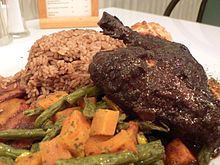Caribbean cuisine

This article covers Caribbean cuisine . In a narrower sense it means the typical cuisine of the Caribbean (West Indies) islands . In a broader sense, however, it also refers to the cuisine of the adjacent coastal areas of the entire Caribbean .
General
The Arawak and Caribs , who populated this region before the Europeans landed, have left their mark on the cuisine of the Caribbean, as have the colonial powers ( Great Britain , Spain , France , the Netherlands ). Slaves from Africa as well as Indians brought in to work in the 19th and 20th centuries brought influences from their respective home regions.
Even if the term Caribbean cuisine is generally used as a generic term, the different histories of the individual islands and coastal regions have led to their own local and regional cuisines, which differ despite many similarities. It should not be overlooked that the majority of the people have been poor over the centuries and that poverty is still a problem in many parts of the Caribbean even today.
In addition, however, an upscale cuisine has also developed that radiates to international cuisine and, conversely, is influenced by it. In the age of large corporations like McDonald’s , however, standardized fast food has also found its way into the Caribbean. In some areas (such as the US Virgin Islands ) it has almost replaced traditional cuisine.
Typical ingredients
The proximity to the sea means that fish and shellfish play an essential role almost everywhere. Salted fish, which used to be a typical meal for slaves, is widespread. Tropical and subtropical types of fruit and vegetables are available in great variety, especially numerous chillies. The large number of local chilli varieties (e.g. the extremely hot Habanero or the Scotch Bonnet (also known as 'Goat Chili')) gives many Caribbean dishes a fiery spiciness. The chillies are often used in pepper sauces.
There are also fruits and vegetables of European origin. Especially legumes are much consumed. Rice , sweet potatoes , cassava , yams , potatoes and plantains serve as a side dish . Also typical is the use of okra and beans .
Almost everything known from Europe can be found on domestic animals , but no European game . Indigenous wild animals are occasionally consumed for this purpose (e.g. iguana or agouti ).
The strong dominance of sugar cane cultivation has not only made sugar , but also the rum made from it, a symbol of the Caribbean. In addition, find molasses (sugar syrup) and the expressed juice of the sugar cane use in the kitchen. In Hispaniola , a traditional drink, Mamajuana, is made, which mainly consists of rum, honey and a mixture of woods and herbs and is used as a digestif or medicinal schnapps.
Typical spices
In addition to local spices such as allspice and long coriander ( cilantro ), nutmeg and ginger, cultivated in Grenada, play a major role. Cloves and cinnamon are also widely used . However, the use of numerous hot chillies is a special feature of Caribbean cuisine. East Indian influences have led to the introduction of relishes and chutneys as a side dish to rice dishes and curries . The best-known Indian spice blend used in the Caribbean is garam masala made from coriander, anise, cloves, fennel , cumin, cardamom , sesame , black pepper, cinnamon, nutmeg and bay leaf . Other typical seasoning ingredients are green pepper, onions, garlic and a tomato paste.
A common Caribbean seasoning sauce is called Sofrito and consists of pepper , herbs, olive oil and annatto . A distinction is made between red sofrito from red sweet peppers and / or tomatoes and green sofrito from green parikas. In Puerto Rico , most main dishes are flavored either with sofrito or with the herb and spice mixture Adobo . In Cuba , on the other hand , Adobo is a marinade for meat that contains orange or lime juice. A spicy sauce made from bitter oranges is called mojo here .
In the French-influenced Caribbean, a sauce chien is served with fish, seafood and poultry at the table , which is quite hot and consists mainly of vegetables. A hot sauce based on vinegar is called picklese here . Spicy olive oil ( fire oil ) is used throughout the Caribbean , for which chili peppers are marinated in oil.
Cocktails
The Caribbean is also known for its cocktails .
Well-known cocktails:
literature
- Lynn Marie Houston: Food Culture in the Caribbean. 2005, ISBN 0-313-32764-5
- Heidi Keller, Miranda Greaves: Caribbean cooking. Courts and their history. Edition dia, St. Gallen, 2nd edition 1993. ISBN 978-3-86034-122-3
- Cornelia Zingerling: The Caribbean cuisine - exotic dishes and tropical drinks from the Caribbean islands. Munich 1994, ISBN 3-453-07723-7
- Wiebke Beushausen, Anne Brüske, Ana-Sofia Commichau, Patrick Helber, Sinah Kloß: Caribbean Food Cultures: Culinary Practices and Consumption in the Caribbean and Its Diasporas. transcript Verlag, Bielefeld 2014, ISBN 978-3-8376-2692-6
- Linda Bladholm: Latin & Caribbean Grocery Stores Demystified . Renaissance Books, Los Angeles 2001, ISBN 1-58063-212-2 .